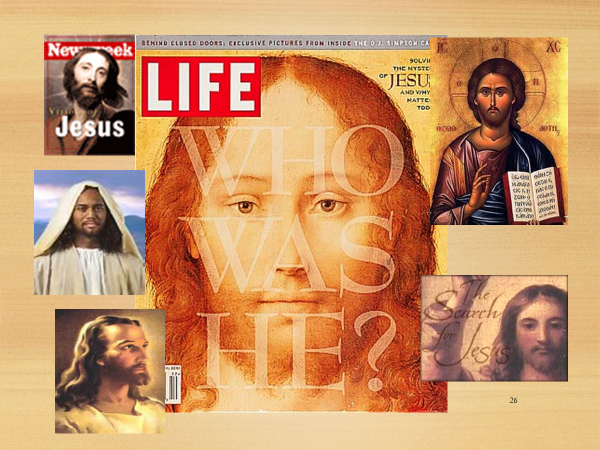“Who Do you Say I Am?”: Cultural Confusion and the Identity of Jesus
By Eric Chabot, CJFM Midwest Representative
Now when Jesus came into the district of Caesarea Philippi, He was asking His disciples, “Who do people say that the Son of Man is?” And they said, “Some say John the Baptist; and others, Elijah; but still others, Jeremiah, or one of the prophets.” He said to them, “But who do you say that I am?” Simon Peter answered, “You are the Christ, the Son of the living God.” And Jesus said to him, “Blessed are you, Simon Barjona, because flesh and blood did not reveal this to you, but My Father who is in heaven.” (Matthew 16:13-17).
As of today, people are still trying to answer the same question that Jesus asked Peter 2,000 years ago. In his book The Case For The Real Jesus, Lee Strobel says if you search for Jesus at Amazon.com, you will find 175,986 books on the most controversial figure in human history.
Here are some of the current views of Jesus in the surrounding culture:
Here we also see Mormons have their own view of Jesus:
We have also have those that have their identity wrapped up in politics. Both sides assume Jesus falls more in line with their political party.
To see more about The Black Hebrew Israelite Movement, see here:
To see one of many responses to the Aslan book, see here:
To see a response to the Smuley book, see Michael Brown’s book here.
As see here, there is plenty of confusion about who Jesus is. For over 100 years, there has been a quest to identify the historical Jesus and differentiate between the Jesus of history and the Jesus of faith. Here are some of the aspects of these quests.
Books That Deal With These Issues
I quickly want to mention two books. I advise reading The Jesus Legend: A Case for the Historical Reliability of the Synoptic Jesus Tradition: By: Paul Rhodes Eddy, Gregory A. Boyd and Jesus and the Eyewitnesses: The Gospels as Eyewitness Testimony: by Richard Bauckham. Bauckham’s book is very significant in that he lays out some of the differences between ancient and modern historiography. After all, this issue plays a tremendous role in understanding the Gospels/New Testament (see more below). And by the way, The Jesus Legend is critical response to legend theorists. For those that want to see how silly it is to propose the theory that Jesus didn’t exist- click here to read Did Jesus Really Exist? By Paul L. Maier, The Russell H. Seibert Professor of Ancient History, Western Michigan University
Let’s Look at the Quests
The First Quest Period-1778-1906:
The First Quest was marked by works such as David Strauss’s, The Life of Jesus Critically Examined. Under the influence of David Hume, Strauss dismissed the reliability of historical and supernatural elements in the Gospels as “outrageous” and “myths” Another important work of this period was Albert Schweitzer’s The Quest of the Historical Jesus. (1)
The No Quest Period-1906-1953:
Rudolf Bultmann regarded Schweitzer’s work as methodologically impossible and theologically illegitimate. (2) Schweitzer’s thesis marked the end of the Old Quest and the beginning of the No Quest period. Through the first half of the twentieth century, the pursuit of the historical Jesus seemed to some scholars to be futile and irrelevant. The failure of the Old Quest, as N.T. Wright has said, had left a “deep ditch” separating the Jesus of history from the Christ of faith. During the period of the No Quest, critical scholars became more interested in examining the New Testament for what it revealed about the early church and its evolving message. Rudolph Bultmann was a primary leader in what is called form criticism during this period. Form criticism sought to draw distinction between various literary forms within the gospels- parables, pronouncements, proverbs and so on- and to identify the stages of development of the texts and the traditions behind them as they passed from oral to written form. (3)
The New Quest Period- 1953-1970:
Ernst Kasemann, a student of Bultmann began the “new quest” in a 1953 lecture. While he rejected some of Bultmann’s views, he was concerned with the person of Jesus as the preached word of God and his relation to history. The major work of the new quest is Gunther Bornkamm’s Jesus of Nazareth (1960). (4) Among the New Questers were German scholar Joachim Jeremias whose works in the 1950’s and the 1960’s focused heavily on the message of Jesus rather than on reconstructing a full-blooded biography. In the United States, the groundwork for the New Quest was laid by the eminent New Testament scholar James Robinson of the Claremont School of Theology, whose 1959 book called A New Quest of the Historical Jesus defined many of the issues that would come to dominate the scholarly community for decades.(5)
Weaknesses of The First Quest, The No Quest and The New Quest:
Naturalism: The naturalistic worldview came to be more prominent during the Enlightenment period. In this worldview, miracle accounts and any references to the non-natural realm are generally rejected. This is unjustified. For theists, miracles (which are paramount to the Christian faith) are non-natural but not anti-natural. A miracle, of course, is a special act of God in the natural world, something nature would not have done on its own. (6) It is beyond the scope of this article to defend the philosophical basis for miracles. For an excellent treament of this topic, feel free to read Norman L. Geisler. Miracles And The Modern Mind: A Defense of Biblical Miracles (Grand Rapids: Baker Books, 1992).
Therefore, the entire starting point in studying the life of Jesus is about one’s presuppositions. Metaphysics is the study of being or reality. It is used interchangeably with ontology (Gk. ontos, “being,” and logos, “word about”). Without metaphysics, a person would be incapable of constructing a worldview. A worldview must explain all of the pieces of the puzzle we call reality.
These issues demonstrate that in investigating the evidence for the life of Jesus, every historian interprets the past in direct relationship to his own Weltanschauung (the German word for worldview). Hence, a worldview will always impact one’s historical method/philosophy of history. Philosophical or metaphysical naturalism refers to the view that nature is the “whole show.” If one has a commitment to philosophical or metaphysical naturalism, several aspects of the life of Jesus will be interpreted in a naturalistic way. Remember, naturalism is not a discovery of science. It must always be viewed as a presupposition of science as presently practiced.
To read more about this issue- see the Boyd/Eddy book or The New Testament and the People of God by N.T. Wright. There is also new book by Mike Licona called The Resurrection of Jesus: A New Historiographical Approach.
A false separation: These quests fail to show that there needs to be a dichotomy between the Jesus of faith and the Jesus of history. They assume the Gospels are non-historical. (7) In relation to the resurrection, Ben Witherington III says:
“Any position in which claims about Jesus or the resurrection are removed from the realm of historical reality and placed in a subjective realm of personal belief or some realm that is immune to human scrutiny does Jesus and the resurrection no service and no justice. It is a ploy of desperation to suggest that the Christian faith would be little affected if Jesus was not actually raised from the dead in space and time. A person who gives up on the historical foundations of our faith has in fact given up on the possibility of any real continuity between his or her own faith and that of a Peter, Paul, James, John, Mary Magdalene, or Priscilla. The first Christian community had a strong interest in historical reality, especially the historical reality of Jesus and his resurrection, because they believed their faith, for better or for worse, was grounded in it.” (8)
A non-Jewish Jesus: Many Jewish scholars view the “New Quest” period as just another attempt to “de-Judaize Jesus” or deny his Jewishness.
The Third Quest Period-1970 and on:
As of today, biblical scholars have embarked on what is called “The Third Quest” for the historical Jesus, a quest that has been characterized as “the Jewish reclamation of Jesus.” Rather then saying Jesus broke away from Judaism and started Christianity, Jewish scholars studying the New Testament have sought to re-incorporate Jesus within the fold of Judaism.(9) In this study, scholars have placed a great deal of emphasis on the social world of first- century Palestine. The scholars of the Third Quest have rejected the idea that the Jesus of the New Testament was influenced by Hellenic Savior Cults. (10) Some of the resources that deal with this issue are the following:
The Players in the Third Quest
1. E.P Sanders
Sanders is noted for asserting in 1985 the historical authenticity of eight activities of The Historical Jesus:
1. Jesus was baptized by John the Baptist 2. Jesus was a Galilean who preached and healed. 3. Jesus called disciples and spoke of their being twelve 4. Jesus confined his activity to Israel 5. Jesus engaged in controversy about the temple 6. Jesus was crucified outside Jerusalem by Roman authorities 7. After his death Jesus’ followers continued as an identifiable movement 8. At least some Jews persecuted at least parts of the new movement
In 1993, in a more popular work, Sanders added six more facts to his list:
1. Jesus was born circa 4 B.C., at the approximate time of Herod the Great. 2. Jesus grew up in Nazareth of Galilee 3. Jesus taught in small villages and towns and seemed to avoid cities 4. Jesus ate a final meal with his disciples 5. Jesus was arrested and interrogated by Jewish authorities, apparatnly at the orders of the High Priest 6. Although they abandoned Jesus after his arrest, the disciples later “saw” him after his death. This led the disciples to believe that Jesus would return and found the kingdom.
Both E.P. Sanders and James Charlesworth say “the dominate view today seems to be that we can know pretty well what Jesus was out to accomplish, that we can know a lot about what he said, and that those two things make sense within the world of first- century Judaism.” (11)
2. N.T. Wright
Wright has been another major player in the Third Quest. Wright agrees with Sanders list but still adds some of the following items about what we can know about Jesus:
1. Jesus spoke Aramaic and Hebrew, and probably some Greek 2. Jesus summoned the people to repent 3. Jesus made use of the parables to announce the kingdom of God 4. Jesus effected remarkable cures, including exorcisms, as demonstrated the truth of his proclamation of the kingdom 5. Jesus shared table fellowship with a socially and diverse group, including whom many Torah observant Jews would regard as “sinners.’
In his book Jesus and the Victory of God,Christian Origins and the Question of God, Volume 2, author Wright says that the historical Jesus is very much the Jesus of the gospels: a first century Palestinian Jew who announced and inaugurated the kingdom of God, performed “mighty works” and believed himself to be Israel’s Messiah who would save his people through his death and resurrection. “He believed himself called,” in other words says Wright, “to do and be what, in the Scriptures, only Israel’s God did and was.”
3. Craig Evans
One of the active scholars in the Third Quest is Craig Evans. One of his recent books is Fabricating Jesus: How Modern Scholars Distort the Gospels. I had the privilege of sitting under Dr. Evans this past May. His knowledge of the Dead Sea Scrolls, early Judaica, and the cognate languages is unsurpassed.
Evans adds a few items to the lists of Sanders and Wright: 1.The public viewed Jesus as a prophet 2. The Romans crucified him as “King of the Jews.” 3.That following Easter his followers regarded him as Israel’s Messiah.
The Core Facts
Gary Habermas makes an important point when he says, “Certainly one of the strongest methodological indications of historicity occurs when a case can be built on accepted data that are recognized as well established by a wide range of otherwise diverse historians.”Historian Christopher Blake refers to this as the “very considerable part of history which is acceptable to the community of professional historians.” (12)
Here are five well-evidenced facts granted by virtually all scholars who study the historical Jesus: (see See Habermas. G.R. and Licona, M. L. The Case for the Resurrection of Jesus):
1. Jesus’ death by crucifixion 2. Jesus’ followers sincerely believed Jesus rose from the dead 3. Early eyewitness testimony to belief in Jesus’ resurrection 4. The conversion of Jesus’ skeptical brother, James 5. Paul, once an enemy of the early faith, became a commited follower of Jesus the Messiah
Who are some of these critical scholars that Habermas mentions? To read more about this see: http://preventingtruthdecay.org/jesusresurrection.shtml
It is important to understand that I don’t want to say that just because I offer a list of core facts that are universally agreed on by historians and Biblical scholars makes it true. If so, that would be what is called a “consensus gentium fallacy” which is the fallacy of arguing that an idea is true because most people believe it. Habermas completed an overview of more than 1,400 critical scholarly works on the resurrection from 1975 to 2003. He studied and catalogued about 650 of the texts in English, German and French. Habermas reports that all the scholars who were from across the ideological spectrum agreed on the five facts that are mentioned. Therefore, the scholars and historians that Habermas researched were not all from a conservative or traditional perspective. So there was some impartiality in the study.
The Jesus Seminar
It is important to mention that another group of scholars who are involved in the Third Quest are the Jesus Seminar. The Jesus Seminar come from various academic, professional, and religious backgrounds. Among the seventy scholars and laypersons that comprise the group, the individuals that are regularly in the public eye include Robert W. Funk (co-chair), John Dominic Crossan (co-chair), and Marcus Borg (Oregon State University). For most of those in the Seminar, there is a dichotomy between the “Jesus of history” and the “Christ of faith.” The “Christ of faith” is seen as a figure of the early church who was elevated to a divine status by the use of early Christian creeds and through the mythological embellishment accounts of the Gospels that were written later. (13) In a debate with John Dominic Crossan of the Jesus Seminar, William Lane Craig exposed Crossan’s naturalistic presuppositions. Craig asked Crossan if there was anything that would convince Crossan that Jesus rose from the dead as an historical fact. Crossan responded by saying a person has the right to say,”I by faith believe that God has intervened in the resurrection event.” However, Crossan then goes on to say, “It’s a theological presupposition of mine that God does not operate in that way that they.” (14) To see some critques of Crossan and the Seminar’s views see here:
Conclusion:
The good news is that the quest for The Historical Jesus may be shifting to what is called “The Interdisciplinary Quest.” This means that there are many people from a variety of academic backgrounds such as philosophy, sociology, anthropology, etc., that are all weighing in on this topic. It should be interesting to see what happens in the future. I can only speak for myself in that I see no dichotomy between the Christ of Faith and the Jesus of History. You can decide for yourself.
NOTE: SEE OUR RESOURCE PAGE HERE:
ALSO SEE OUR SUGGESTED READING LIST
Sources:
1.Geisler N. Baker Encyclopedia of Christian Apologetics. Grand Rapids, MI: Baker Books, 1999, pgs 385-386. 2.Ibid. 3. Sheller, Jeffrey L. Is The Bible True? How Modern Debates and Discoveries Affirm the Essence of the Scriptures, New York. Harper Collins Publishers. 1999, 176-182. 4.Ibid. 5.Ibid. 6.Geisler, pgs 385-386. 7.Ibid. 8.B. Witherington III. New Testament History. Grand Rapids, MI: Baker Academic. 2001, pg 167. 9.Craig, W L. Christian Reasonable Faith, Wheaten, ILL: Crossway Books. 1984, 240-241. 10. Ibid. 11. Ibid. 12. Geisler, N.L., and Paul K. Hoffman, Why I Am A Christian: Leading Thinkers Explain Why They Believe. Grand Rapids: MI: Baker Books. 2001, 152.
13. House. W.H.,and Joseph M. Holden, Charts of Apologetics and Christian Evidences.Grand Rapids, MI: Zondervan Publishing House, 2006, Chart 51.
14. Copan, P. Will The Real Jesus Stand Up? A Debate between William Lane Craig and John Dominic Crossan. Grand Rapids, MI: Baker Books. 1998. 61-62.
Subscribe
Receive email updates when we post a new article by subscribing.
Categories
- Eric Chabot 71 entries
- Gary Hedrick 125 entries
Recent Posts
- What Does It Mean to Say Jesus is "The Son of God?"
- If God forbids human sacrifice in the Old Testament, how does the sacrifice of Jesus make sense?
- Why My Favorite Question for College Students is “Does God Exist?”
- Jewish scholar Michael S. Kogan on the uniqueness of Jesus’s messianic movement
- “Do the Miracles of Jesus Prove Messianic Status?”













Tagged
No tags